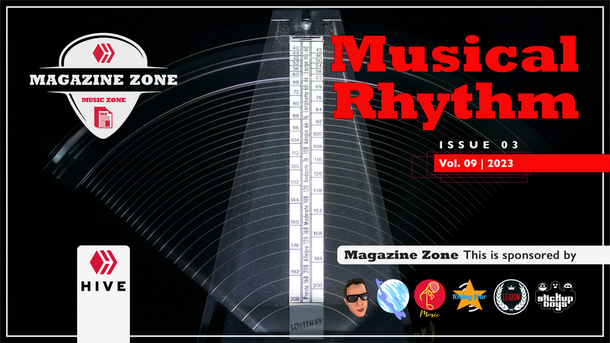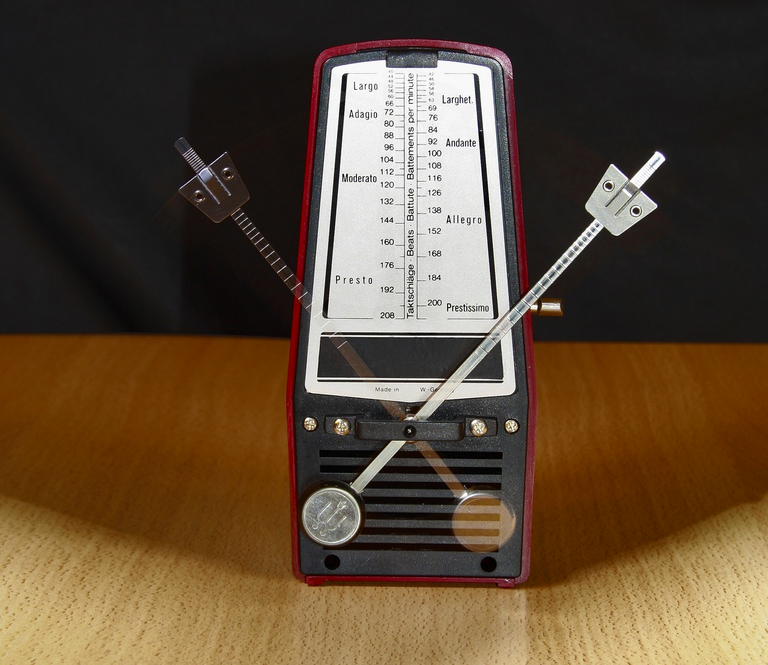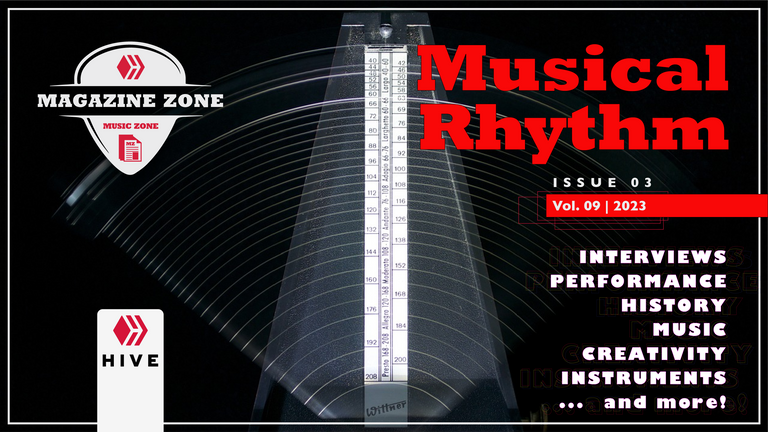Magazine Zone: Musical Rhythm | Issue 03 - Vol. 09 [ENG-ESP]

Source | Fuente
Musical Rhythm
Ritmo Musical
Most of the arts have shown us a fundamental aspect that speaks to us of action, movement, flow; that is to say, that art possesses a basic characteristic: Rhythm. We can perceive this element in different arts, in theater, painting, architecture, sculpture, poetry and music. As long as we distribute things in such a way that there is a relationship between them, in time or space, we can say that there is an established rhythm. We can note that this characteristic can be visual and sonorous. In music, the rhythm is given by the sounds that are repeated in time. We explained in our Volume 02: Elements of music where, probably, rhythm came from, and that this was the first musical element, as well as what rhythm is. Summarizing, we said that rhythm is a succession of sounds distributed in time, and that these are repeated.
La mayoría de las artes nos han mostrado un aspecto fundamental que nos habla de acción, de movimiento, de flujo; es decir, que el arte posee una característica básica: El Ritmo. Este elemento lo podemos percibir en distintas artes, en el teatro, la pintura, la arquitectura, la escultura, la poesía y en la música. Siempre y cuando distribuyamos las cosas de manera que exista una relación entre ellas, en el tiempo o en el espacio, podemos decir que hay establecido un ritmo. Podemos notar que esta característica puede ser visual y sonora. En la música, el ritmo viene dado por los sonidos que se repiten en el tiempo. Explicamos en nuestro Volumen 02: Elementos de la música de donde, probablemente, venía el ritmo, y que este, era el primer elemento musical, así como también qué es el ritmo. Resumiendo, decíamos que el ritmo es una sucesión de sonidos distribuidos en el tiempo, y que estos se repiten.

Source | Fuente
When we pay attention to music, one of the elements that catches our attention in the first instance is the rhythm, whether or not we have knowledge of music. All the music that our ears perceive has rhythm, it is something natural and spontaneous. The way sounds happen and are organized are particular in the different songs we listen to, and they can be recognized by the emphasis and the time they last. Emphases can be weak or strong, while the duration of the sound can be short or long. These are basic aspects of rhythm. Delving a little deeper into Rhythm, we find that it is linked to other basic concepts, which are: pulse, accent, and meter.
Cuando prestamos atención a la música, uno de los elementos que nos atrapa en primera instancia es el ritmo, se tenga o no conocimientos de música. Toda la música que perciben nuestros oídos poseen ritmo, es algo natural y espontáneo. La forma como suceden y se organizan los sonidos son particulares en las distintas canciones que escuchamos, y pueden ser reconocibles por los énfasis y el tiempo es que estos duran. Los énfasis pueden ser débiles o fuertes, mientras que la duración del sonido puede ser corta o larga. Estos son aspectos básicos del ritmo. Profundizando un poco en el Ritmo, encontramos que este está vinculado a otros conceptos básicos, que son: el pulso, el acento, y el compás.
The Pulse
El Pulso

It is the minimum unit of time, and helps to divide the sound space into equal portions. The pulse can be regular or irregular, and can vary its speed within the same musical work, if so decided. The pulse is perceived as a basic aspect to enter into the study of a work. The duration of these pulses is what we call the Tempo, and it is constant during the whole song, that is to say, the tempo indicates the speed of the song.
Es la unidad mínima de tiempo, y ayuda a dividir el espacio sonoro en porciones iguales. El pulso puede ser regular o irregular, y puede variar su velocidad dentro de una misma obra musical, si así se decide. El pulso es percibido como un aspecto básico para entrar en el estudio de una obra. La duración de estos pulsos es lo que llamamos el Tempo, y es constante durante toda la canción, es decir, el tempo indica la velocidad de la canción.




The creation of the metronome has been very useful to note the speed at which a piece of music should be played. History indicates that Beethoven was the one who began to describe this time metronome in his scores, a habit that has been established to this day. We have heard Italian words such as Moderato, Allegro and Andante, which are terms that indicate the tempo of the musical work. These terms, to refer to the speed of the work, have a speed range known as BPM, which stands for Beats Per Minute. In the metronome, this value indicates the division of time in a minute, so the higher this number is, the faster the piece will be. The tempo basically defines the expression of the musical work.
La creación de metrónomo ha sido muy útil para apuntar la velocidad en que debe ejecutarse una pieza musical. La historia indica que Beethoven fue quien empezó a describir este metraje del tiempo en sus partituras, hábito que se ha establecido hasta la fecha. Hemos escuchado palabras italianas como Moderato, Allegro y Andante, son términos que nos indican el tempo de la obra musical. Estos términos, para referirse a la velocidad de la obra, poseen un rango de velocidad conocido como BPM, que significa Beats por Minuto. En el metrónomo, este valor indica la división del tiempo en un minuto, por lo que mientras más alto sea este número, más rápida será la pieza. El tempo básicamente define la expresión de la obra musical.
The Accent
El Acento

It is an emphasis that is assigned to a specific pulse, which differentiates it from the rest, that is to say, this pulse stands out audibly from the rest of the pulses that do not have accent. This particularity is important because it helps to organize the notes in a specific way, according to the phrase being developed. Usually, the first pulse has an intrinsic accentuation, although it can be the case that the first pulse has no accent, then we find more complex rhythms. The accents allow to give particularity to the musical expression within the work or, to contribute essential characteristics to certain musical styles. The accents collaborate in the organization of the notes, therefore, they collaborate in the metric, and gives appearance to our last concept of the rhythm: The Compás.
Es un énfasis que se le asigna a un pulso en específico, que lo diferencia del resto, es decir, este pulso se destaca audiblemente del resto de los pulsos que no poseen acento. Esta particularidad resulta importante porque ayuda a organizar las notas de manera específica, según la frase que se desarrolle. Por lo regular, el primer pulso tiene una acentuación intrínseca, aunque puede darse el caso que el primer pulso no tenga acento, allí nos encontramos con ritmos más complejos. Los acentos permiten darle particularidad a la expresión musical dentro de la obra o, a aportar características esenciales a ciertos estilos musicales. Los acentos colaboran en la organización de las notas, por ende, colaboran en la métrica, y da aparición a nuestro último concepto del ritmo: El Compás.




The Compass
El Compás

It represents the order and structure of the musical idea. Its purpose is to divide the musical narrative into equal or similar portions. Within the measure is immersed the metric, there coexist the pulse and the accents. There are many ways of organizing the measures, according to the number of beats established within each one. This aspect of rhythm implies a deeper theory that we will discuss in more detail in future volumes. Understanding these concepts helps us to respect them for a better understanding of the music and specific themes, as well as to improve as musicians.
Representa el orden y la estructura de la idea musical. Su finalidad es dividir la narrativa musical en porciones iguales, o parecidas. Dentro del compás está inmerso la métrica, allí conviven el pulso y los acentos. Hay muchas maneras de organizar los compases, según el número tiempos que se establezca dentro de cada uno. Este aspecto del ritmo implica teoría más profunda que tocaremos con más detalles en próximos volúmenes. El entendimiento de estos conceptos nos ayudan a respetarlos para un mejor entendimiento de la música y temas específicos, así como también de mejorar como músicos.

A word from Jesús
Unas palabras de Jesús
 Por: Jesús Tortolero | @yisusth
Por: Jesús Tortolero | @yisusth If there is one element that cannot be missing in music, it is rhythm. It gives direction, balance and dynamism to a piece of music. In the study of musical language, the perception of meter and pulse is vital. One must cultivate the ability to adapt to the tempo or movement. The metronome is a device that helps us to establish the speed of the pulse. There are different devices, both analog and digital, that give us acoustic and visual signals. The movements of the human body and living beings have their pulse, and their own rhythm. All people are different in this parameter. When playing in an orchestra everyone must go to the same pulse, that is why it is necessary to have direction and adapt as a whole to the beats per minute PPM. That is why the musician must cultivate this synchronization skill, so that there is unity and coherence. Other aspects to be considered in the study are the meter of the compass and the accentuation.
Si hay un elemento que no puede faltar en la música es el ritmo. Este le da dirección, balance y dinamismo a una pieza musical. En el estudio del lenguaje musical es vital la percepción de la métrica y del pulso. Uno debe cultivar la habilidad de adaptarse al tempo o movimiento. El metrónomo es un dispositivo que nos ayuda a establecer la velocidad del pulso. Existen diferentes dispositivos, tanto analógicos como digitales, que nos dan señales acústicas y visuales. Los movimientos del cuerpo humano y de los seres vivos tienen su pulso, y su propio ritmo. Todas las personas son diferentes en este parámetro. Cuando se toca en una orquesta todos deben ir al mismo pulso, es por eso por lo que es necesario tener dirección y adaptarse en conjunto a las pulsaciones por minuto PPM. Por eso el músico debe cultivar esta habilidad de sincronización, de tal manera que exista unidad y coherencia. Otros aspectos que se deben considerar en el estudio son la métrica del compás y la acentuación.

Source | Fuente
To compose a musical rhythm, it is necessary to have information in our mind of different patterns and then experiment with them. This pattern or structure is made up of the different elements of rhythm. Each culture has a rhythm that distinguishes them. Today, thanks to the access that technology gives us, we can combine them and create new things. We must also consider that silence is also music, and that they can be mixed with melody. Rhythm is not only characteristic of percussion instruments, it is also essential in melodic and harmonic instruments. The rhythm can have different voices, or lines, which when joined together harmonize. Sound effects can also be added.
Para componer un ritmo musical, es necesario contar con información en nuestra mente de diferentes patrones y luego experimentar con ellos. Este patrón o estructura está conformada por los diferentes elementos del ritmo. Cada cultura tiene un ritmo que los distingue. Hoy día, gracias al acceso que nos brinda la tecnología, podemos combinarlos y crear cosas nuevas. También hay que considerar que también el silencio es música, y que se pueden mezclar con la melodía. El ritmo no solo es característico de instrumentos de percusión, también es esencial en los instrumentos melódicos y armónicos. El ritmo puede tener diferentes voces, o líneas, que al unirlas armonizan. También se pueden agregar efectos sonoros.
An example of a rhythmic composition is the 1812 overture Opus. 49 by Russian composer Pyotr Ilyich Tchaikovsky. There is a climactic moment in the piece that includes a cannon salute and a peal of bells in the original score. Imagine the degree of synchronization that the people firing the salvos must have. Not only is it required to be visually attentive to the conductor, but also to coincide with the orchestra. One of the methodologies used in the study of music is the Dalcroze method, which focuses on body movement to work on rhythm, specifically on elements such as eurythmy, solfège and improvisation. Rhythm is also addressed in other methods such as Kodály, Orff Schulwerk and the Suzuki method.
Un ejemplo de composición rítmica es la obertura de 1812 Opus. 49 de compositor ruso Piotr Ilich Chaikovski. Hay un momento de clímax de la pieza que incluye salva de cañones y repique de campanas en la partitura original. Imagínense el grado de sincronización que deben tener las personas que disparan las salvas. No solamente se requiere estar visualmente atento al director, sino también coincidir con la orquesta. Una de las metodologías usadas para en el estudio de la música es el método Dalcroze que se centra en el movimiento corporal para trabajar el ritmo, específicamente en elementos como la euritmia, solfeo e improvisación. El ritmo también es abordado en otros métodos como Kodály , Orff Schulwerk y el método Suzuki.
Rhythm is the essence of life,
and everything is directed
by the Great Creator of all.
El ritmo es esencia de la vida,
y todo lo dirige
el Gran Creador de todo.


🔸


We invite you! | Te invitamos

Music Zone
©2023 - Todos los derechos reservados
©2023 - Todos los derechos reservados








https://twitter.com/105857675/status/1648737073237458955
https://twitter.com/1614754069226061824/status/1648762512236503055
https://twitter.com/1050873202078085121/status/1648802944366653440
https://twitter.com/1120336377294532614/status/1648820182868021253
https://twitter.com/1648679262700949505/status/1648875530614190080
https://twitter.com/80429371/status/1648883342018740225
The rewards earned on this comment will go directly to the people( @yisusth, @hectgranate, @edwardstobia, @artefactoestudio, @augusto-cordova ) sharing the post on Twitter as long as they are registered with @poshtoken. Sign up at https://hiveposh.com.
Interesting one here. I think I've learnt much.
But then, I don't Still understand what this is made up for and how I can be among.
Is it for knowledge sake or?
Please, make clearance on it
Thank you @musiczone
A cordial greeting. The objective of Magazine Zone is to share experiences and information aimed at improving the skills and knowledge of musicians who make content on and off the Blockchain.
Rhythm is one of the essential elements of music. Gradually and progressively we will be sharing content that will be a useful tool in your growth as a musician.
O very well then.
I appreciate your response.
Thank you! Thank you!!!
Hace no mucho tuve la oportunidad de tocar con la orquesta sinfónica de aquí donde vivo, ví en sus partituras las palabras Allegro y Andante, y dije: como rayos se que tan rápido o que tan lento lo debo hacer, como esa palabra te da el tiempo exacto, yo estoy más acostumbrado a escuchar el click en la secuencia, me parece muy interesante el saber cómo lo hacen como interpretan el tiempo exacto, como lo interpreta el director
El ritmo es la vida de la música, no solo por la percusión, en toda la música hay elementos que pueden hacer y hacen ritmos, la música sin ritmo no sería nada, brutal su post 🤘🏻🤘🏻
Si, es muy interesante lo que hablas. Esas indicaciones de tiempo pueden ser subjetivas. Fue cuando inventarón el metronomo cuando ya podian establecer una medición exacta del tiempo. Las palabras siguen usandose pero ya se conoce que Allegro equivale a 120 negras por minuto. Hoy existen mediciones más exactas.
Muchisimas gracias por tus amables palabras. Nos alegra la recepción. Que no pare la música.
Bro. Tienes una narrativa rica con variada, disfrute leer de este post y como músico me parece bastante buena tus definiciones, aunque si seguimos indagando más en el tema de ritmos y musicas, horas de aprendizaje y diversión tenemos aseguradas. Me gusta mucho que estés en esta onda de definir y explicar la música.
Amigo, @elturimiquire, antes que nada, recibe una gran disculpa de nuestra parte por no lograr atenderte hace 5 días.
Gracias por tu comentario, nos alegra que te disfrutes el aprendizaje con este Magazine que hacemos con mucho cariño y esfuerzo para todos nuestros lectores.
Totalmente de acuerdo, son muchos para abordar que iremos organizando poco a poco.
Agradecemos tu tiempo por estar acá y comentar.
Esperamos verte en el próximo Volumen. Saludos